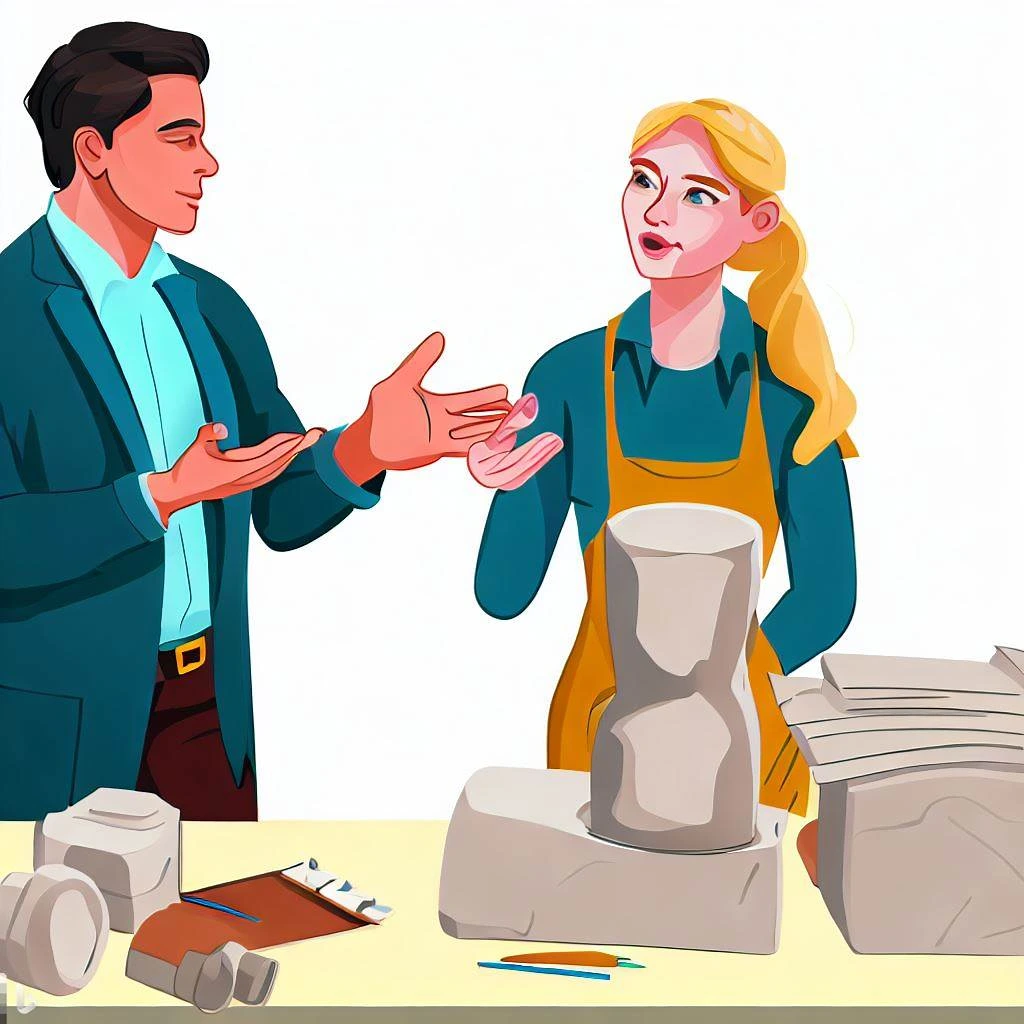A Comprehensive Assignment Guide to Understanding Sculpture Materials


Traditional Sculpture Materials
In this assignment guide, we delve into traditional sculpture materials, investigating their individual characteristics as well as the significance that they've held throughout history. Marble is one such material; it is well-known for having a smooth surface, being extremely durable, and having the ability to hold intricate details. We investigate the enduring allure of marble sculptures, from minute figurines to enormous statues, which serve as illustrative examples of the craftsmanship and artistry required to transform inert blocks of material into mesmerizing works of art. Bronze, an alloy of metals that is well-known for its malleability and resistance to corrosion, is yet another traditional material that we investigate. We delve into the process of casting and the strength of bronze sculptures, which enables the creation of multiple editions and replicas of the sculpture. In addition, we talk about wood as a versatile and approachable material, highlighting the fact that it can be carved, chiseled, or assembled into sculptures that range in size from miniature figurines to large-scale installations. The final piece of artwork takes on a one-of-a-kind personality thanks to the natural warmth and organic texture of wood, which also highlights the connection between nature and sculpture. The readers get a better understanding of the traditional materials used in sculpture by gaining a deeper comprehension of the historical significance of these materials as well as the influence they have on the artistic expression of sculptors.
Marble
Sculptors have consistently shown a preference throughout history for working with marble because it is an everlasting material. The fact that it has a smooth texture, that it is long-lasting, and that it is able to keep intricate details makes it a popular choice for sculpting. The transformation of a block of marble into a work of art can take the form of anything from a minute figurine to a massive statue, and each example demonstrates the artist's mastery of the medium. The timeless beauty and understated elegance of marble is brought to life in works of art such as the sculptures of ancient Greece and David by Michelangelo.
Bronze
Copper and tin are the primary components of bronze, which also contains trace amounts of a number of other metals. Bronze is an alloy. As a result of its malleability and resistance to corrosion, it has been utilized in the art of sculpture ever since ancient times. The durability of bronze sculptures, along with their ability to capture the subtleties of human forms, has earned them a well-deserved reputation. Due to the fact that the casting process used in the production of bronze sculptures permits the creation of multiple editions, this medium is frequently used for the production of limited editions and replicas of well-known works of art.
Wood
Wood is a material that has been sculpted into various forms across a wide range of time periods and cultures because of its adaptability and accessibility. Sculptors have access to a variety of unique properties, depending on the type of wood they work with, such as oak, mahogany, or ebony. Different methods, such as carving, chiseling, or assembly, can be used to create sculptures out of wood, and the finished products can range in size from miniature figurines to expansive installations. The natural warmth and organic texture of wood lend a one-of-a-kind quality to the finished piece of artwork.
Modern Sculpture Materials
We examine the fascinating world of contemporary sculpture materials in this thorough assignment guide, showcasing their creative applications and allure. Steel is a common substance that is valued for its tenacity, adaptability, and capacity to produce sculptural works that are audacious and striking. Steel sculptures frequently have geometric and abstract patterns, reflecting the modern era's industrial and technological influences. Steel's reflective surface gives the artwork a dynamic quality by interacting with light and the environment. Glass, known for its transparency, luminosity, and capacity to produce ethereal and delicate sculptures, is another fascinating modern sculpture material. Glass is shaped by artists using a variety of techniques, including blowing, casting, and kiln forming, to create intricate and alluring forms. The way that light interacts with glass sculptures creates captivating visual effects that only add to their beauty. Sculptures made of a variety of materials, including textiles, organic components, and found objects, have also become more common in contemporary art. These works are distinctive and thought-provoking. This method permits experimentation, pushing the envelope, and producing multidimensional artistic experiences. Readers learn about the ever-evolving nature of art and the limitless opportunities for creativity in the modern world by investigating these materials for modern sculpture.
Steel
Steel is a relatively new material that has seen significant success in recent years in the field of modern sculpture. Because of its strength, durability, and flexibility, artists are able to experiment with a variety of different sizes and shapes while also exploring new forms. Sculptures made of steel frequently feature abstract and geometric patterns, which are meant to reflect the advances in industry and technology that have occurred in the modern era. The reflective surface of steel contributes an additional dimension of liveliness and interaction with the environment that surrounds it.
Glass
Glass is a material that has made its way into the realm of sculpture despite its fragile nature and captivating qualities. To create works of art out of glass, artists employ a wide variety of processes, including blowing, casting, and kiln forming, amongst others. The mesmerizing effects that are produced by the interaction of glass with light give the artwork a one-of-a-kind quality that stems from the material's transparency and luminosity. Glass sculptures have the potential to be intricate and delicate works of art that capture the essence of beauty and fragility.
Mixed Media
Sculptors working in contemporary art frequently experiment with mixed media, which involves combining different types of materials to produce works that are both original and thought-provoking. Sculptures created with mixed media can incorporate a wide variety of materials, including found objects, textiles, plastics, and even organic materials. By taking this approach, artists are given the opportunity to push artistic boundaries, challenge preconceived notions, and produce works of art that engage viewers on multiple levels.
Factors Influencing Material Selection
To give readers a thorough understanding of the decision-making process, we examine the various factors that affect material selection in sculpture in this assignment guide. The pursuit of beauty is an important factor. When choosing materials, artists take into account their vision and desired emotional impact. Different materials produce distinct visual effects and evoke various emotions, such as the elegance and beauty of marble or the warmth and earthiness of wood. The technical specifications of the selected material are a significant additional factor. Sculptors must take into account the equipment required and the material's usability. For instance, working with bronze necessitates understanding the casting procedure, whereas carving wood necessitates skill in the use of carving implements. When choosing materials, particularly for outdoor sculptures, environmental considerations are also important. Materials' resistance to weather conditions like rain, wind, and sunlight must be taken into account by artists. Due to their resistance to weathering, materials like bronze are more suitable for outdoor installations. Artists can make decisions that are in line with their artistic vision, technical capabilities, and the sculpture's intended context by being aware of these factors.
Aesthetic Goals
The artistic vision and the aesthetic goals of the artist both play an important role in the selection of materials. The use of various materials can elicit a wide range of emotions and produce very specific visual effects. For instance, the polished surface of marble can give off an air of sophistication and beauty, whereas the rough texture of wood can conjure up feelings of earthiness and cosines.
Technical Requirements
Every material comes with its own specific set of technical requirements and constraints. Sculptors are required to take into consideration a variety of factors, including the tools that are required, how simple it is to work with the material, and how easily it is possible to achieve the desired level of detail. For example, working with bronze necessitates familiarity with the casting process, whereas carving wood calls for an in-depth understanding of various carving tools.
Environmental Factors
It is essential to take into consideration where the sculpture will be displayed. Sculptures that are displayed outside must be able to withstand the elements, such as rain, wind, and sunlight, all of which have the potential to diminish the material's durability and aesthetic appeal. Due to their resistance to the effects of weathering, certain materials, such as bronze, are better suited for use in outdoor installations.
Conclusion
This guide offers a comprehensive understanding of the qualities and importance of each material by exploring both conventional and contemporary options, from the classic elegance of marble and bronze to the modern allure of steel and glass. In order to help readers make wise choices in their artistic endeavors, it explores the factors that affect material selection, such as aesthetic goals, technical requirements, and environmental considerations. This guide provides a wealth of information to improve your understanding of sculpture materials and their function in the creative process, whether you're a student working on an assignment or an artist looking for inspiration. This book is a reliable companion in exploring the fascinating world of sculpture materials because it combines historical context, technical expertise, and useful advice.